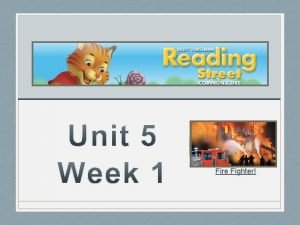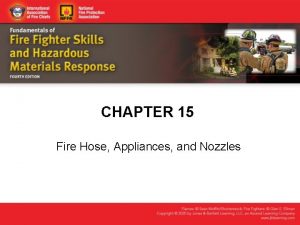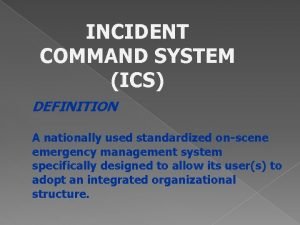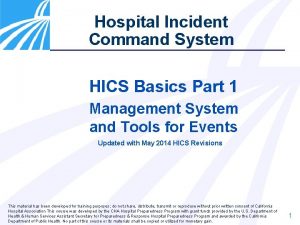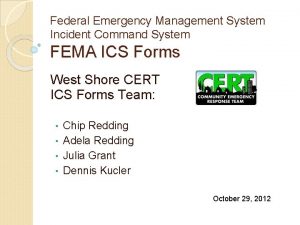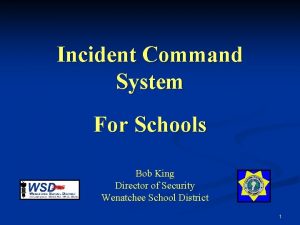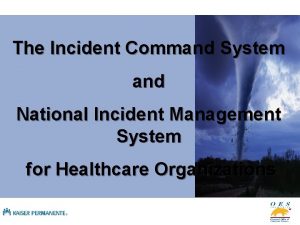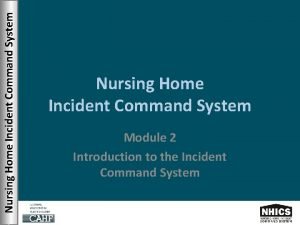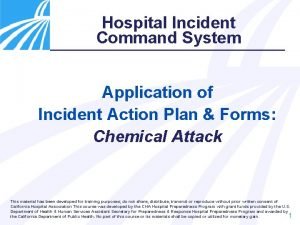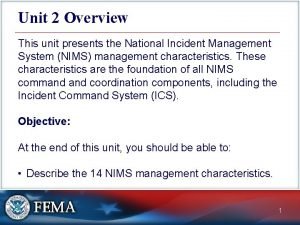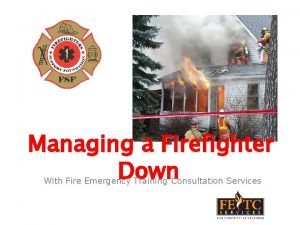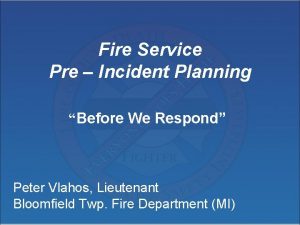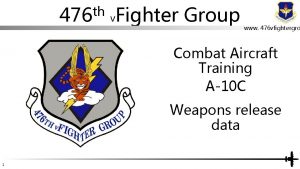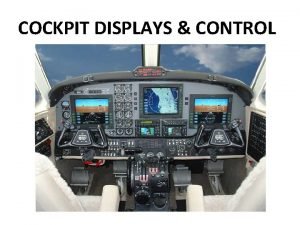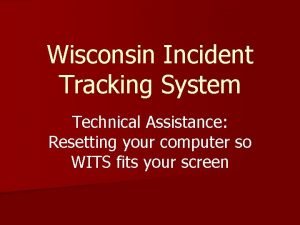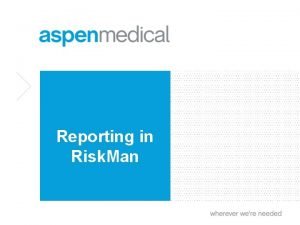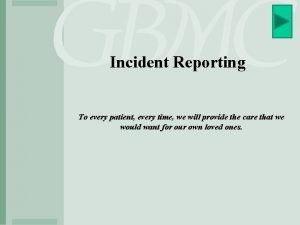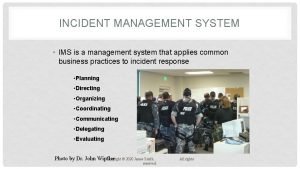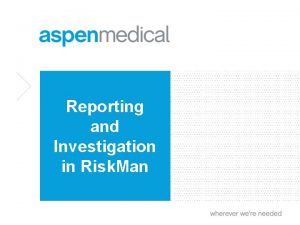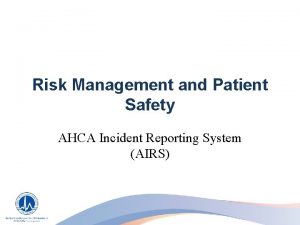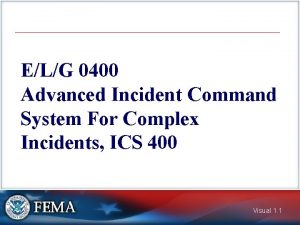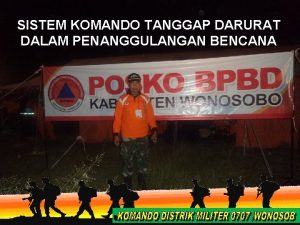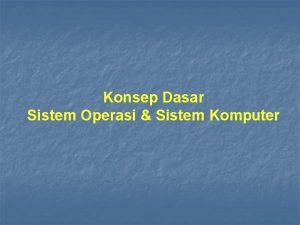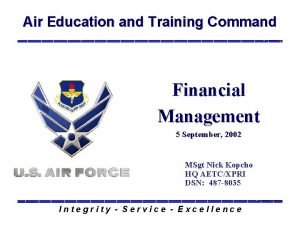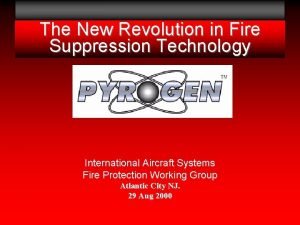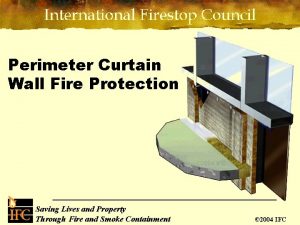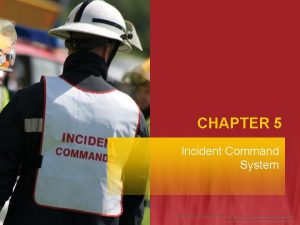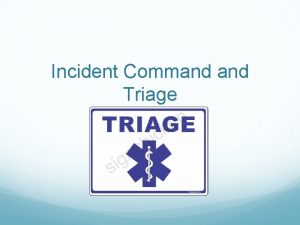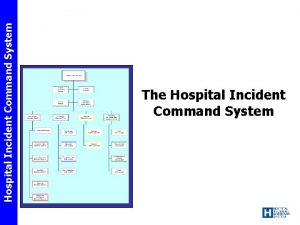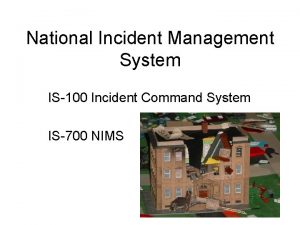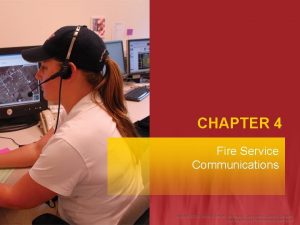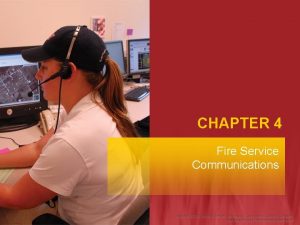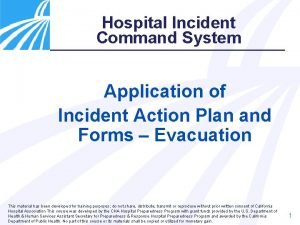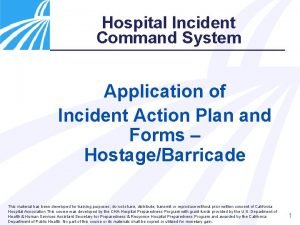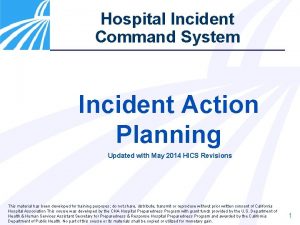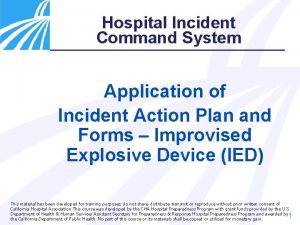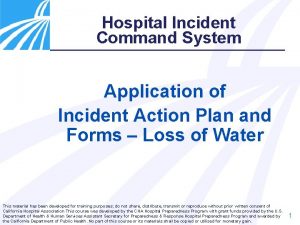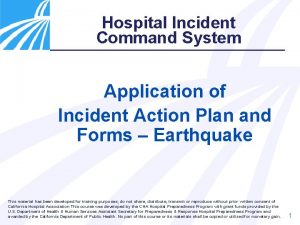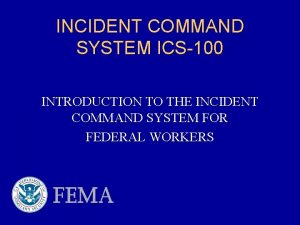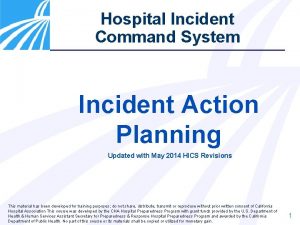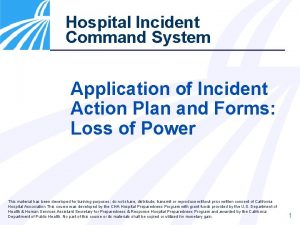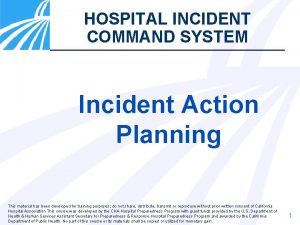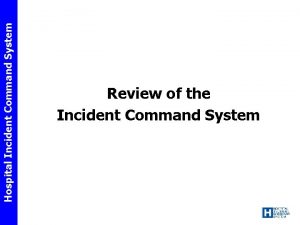CHAPTER 5 Incident Command System Fire Fighter II


















































- Slides: 50

CHAPTER 5 Incident Command System

Fire Fighter II Objectives • Describe the characteristics of the Incident Command System (ICS). • Explain the organization of the ICS. • Function within an assigned role within the ICS.

Fire Fighter II Objectives • Organize and coordinate an ICS until command is transferred. • Transfer command within an ICS.

Introduction • ICS should be used for all operations and training. • National Incident Management System (NIMS) – Defines standards and guidelines nationally – Variations exist. – Every fire fighter must know local procedures thoroughly.

History of ICS • Pre-1970 s – Every fire department had its own methods of incident management. – Organization often depended on the style of the chief on duty. – Such an approach did not work well with other units or mutual aid companies.

History of ICS • 1970 s – FIRESCOPE • Developed first standard ICS – Fire-ground command system (FGC) • Initially developed for day-to-day department incidents

History of ICS • 1980 s – FIRESCOPE ICS adopted by all federal and most state wildland firefighting agencies – Several federal regulations and consensus standards adopted • Present – ICS is best of ICS and FGC.

Characteristics of the ICS • • • Recognized jurisdictional authority Applicable to all risk and hazard situations Applicable to day-to-day operations Unity of command Span of control Modular organization

Characteristics of the ICS • • • Common terms Integrated communications Consolidated incident action plans Designated incident facilities Resource management

Jurisdictional Authority • Identification at smaller incidents is usually not a problem. • Unified command used when there are overlapping responsibilities • Single command • Incident action plan (IAP)

All-Risk/All-Hazard System • ICS works equally well at all types of incidents. – Emergencies – Nonemergency events

Everyday Applicability • ICS can be used for everyday operations. • Regular use of ICS builds familiarity with procedures and terms.

Unity of Command • Each person has only one supervisor. • All orders and assignments come from that supervisor. • Best qualified person should be assigned at the appropriate level.

Span of Control • The maximum number of subordinates a supervisor can have • In most situations, three to seven is the most one person can manage. • In ICS, span of control should be limited to five.

Modular Organization • ICS is designed to be flexible and modular. • Not every component must be used. • Additional components can be added as needed.

Common Terms • Terms are common and consistent within and among agencies in the ICS. • Common terms eliminate confusion. – Each word has a single definition. – No two words mean the same thing.

Integrated Communications • Communications supported up and down the chain of command • Messages must move efficiently through the system.

Consolidated Incident Action Plans • Everyone follows one overall plan. • May be developed by the incident commander alone at small incidents • Developed in collaboration with all agencies involved on larger incidents

Designated Incident Facilities • Assigned locations – – – Incident command post Rehabilitation sector Casualty collection point Treatment area Base of operations Helispot

Resource Management • Standard system of assigning and tracking resources involved on the incident • Staging area – Large-scale incidents – Close to incident – Units held in reserve • Personnel are the most vital resource

The ICS Organization • Positions are staffed as needed. • IC position must be filled at every incident.

Command • The incident commander is ultimately responsible for managing the incident. • Command is established when the first unit arrives on the scene as is maintained until the last unit leaves the scene.

Unified Command • Used when agencies overlap • Representatives from each agency cooperate to share command authority.

Incident Command Post • Headquarters location for the incident • Should be in a nearby, protected location – Enables command staff to function without distractions or interruptions

Command Staff • Safety officer • Liaison officer • Public information officer

General Staff Functions • Four section chiefs for the major ICS components: – – Operations Planning Logistics Finance/ administration

Operations • Responsible for all actions that are directly related to controlling the incident – – Fire suppression Rescue Emergency medical services Conducted in accordance with an IAP

Planning • Responsible for the collection, evaluation, and dissemination of information relevant to the incident • Also responsible for developing and updating the IAP

Logistics • Responsible for providing supplies, services, facilities, and materials during the incident

Finance/Administration • Responsible for accounting and financial aspects of an incident • Responsible for any legal issues that may arise • Not staffed at most incidents

Standard ICS Concepts and Terms • One of the strengths of the ICS is its use of standard terms. – Specific terms apply to various parts of an incident organization. – Understanding these basic terms is the first step in understanding the system.

Single Resources and Crews • Single resource – A vehicle and its assigned personnel • Crew – Groups of fire fighters working without apparatus

Divisions and Groups • Division – Geographic • Group – Functional

Branches • Higher level of combined resources working on a particular aspect of the overall emergency • A branch director can oversee several divisions and/or groups.

Location Designators • Identify different parts of a fire scene – Sides – Exposures – Floors

Task Forces and Strike Teams • Groups of single resources assigned to work together • Task force – Up to five single resources of any type

Task Forces and Strike Teams • Strike team – Five units of the same type working on a common task or function

Implementing ICS • Modular design allows organization to expand based on needs. • Tasks are defined in advance.

Implementing ICS • Most frequently used components: – Divisions – Groups

Standard Position Titles • Clarify roles within the ICS organization • Title includes functional/geographic area, followed by designator.

Standard Position Titles

Working Within the ICS • Every fire fighter must understand the ICS and his or her role within it. • Three basic components: – Someone is in command of every incident. – You always report to one supervisor. – The company officer reports to the incident commander.

Responsibilities of First-Arriving Fire Fighters • ICS organization is built around the units that take initial action. • Company officers need to assume command until relieved by a higher-ranking officer.

Establishing Command • The officer of the first-in unit is in command. • This is formally announced on the radio. • An initial report should be given as well.

Confirmation of Command • Initial radio report lets everyone know that command has been established. • An incidentifier should be chosen.

Transfer of Command • One person relinquishes command. • Current situation status report is given to the new incident commander. • Information transfer must be complete and accurate.

Situation Status Report Information • • • Tactical priorities Action plans Hazardous conditions Accomplishments Assessment of effectiveness Current status of resources

Command Transfer Rationale • Transfer of command determined by a variety of factors: – Complexity of the incident – Officer’s level of experience – Involvement of multiple agencies

Summary • ICS provides a standard, professional, and organized approach to managing emergency incidents. • All emergency operations and training exercises should be run using ICS. • All functions in the ICS must be addressed at every incident.

Summary • On smaller incidents, this may only require one person to handle all functions. • The incident commander has ultimate responsibility to manage the incident. • All fire fighters must understand the ICS and what their role in an ICS is.
 Prefix for fire
Prefix for fire Hose appliances
Hose appliances Definition of incident command system
Definition of incident command system Hics org chart
Hics org chart Hospital incident command system fema
Hospital incident command system fema Incident command system schools
Incident command system schools Hospital incident command system powerpoint
Hospital incident command system powerpoint Nursing home chain of command
Nursing home chain of command Incident objectives that drive incident operations
Incident objectives that drive incident operations To avoid overburdening the incident command
To avoid overburdening the incident command Singular incident command
Singular incident command Nfpa pre incident planning
Nfpa pre incident planning African american fighter pilots
African american fighter pilots Kron the alien freedom fighter
Kron the alien freedom fighter Allusion meaning
Allusion meaning Brand hierarchy tree
Brand hierarchy tree Fighter brand examples
Fighter brand examples Lexical ambiguity
Lexical ambiguity Types of literal language
Types of literal language Ccip ccrp
Ccip ccrp Unscramble fighter
Unscramble fighter Digital cockpit display unit
Digital cockpit display unit Fighter sprite sheet
Fighter sprite sheet Sound fighter systems cost
Sound fighter systems cost Reichstag fire who was the fire starter
Reichstag fire who was the fire starter Damper interface panel
Damper interface panel Uttar pradesh fire prevention & fire safety rules, 2005
Uttar pradesh fire prevention & fire safety rules, 2005 Rwi are
Rwi are Race fire
Race fire Wisconsin incident tracking system
Wisconsin incident tracking system Riskman incident reporting
Riskman incident reporting Quantros incident reporting system
Quantros incident reporting system Iqcs new responder form
Iqcs new responder form Ims incident management system
Ims incident management system Riskman incident reporting
Riskman incident reporting Ahca risk management
Ahca risk management Safety incident management system
Safety incident management system Incident business system
Incident business system Advanced incident reporting system
Advanced incident reporting system Fema prep toolkit
Fema prep toolkit Quantros incident reporting system
Quantros incident reporting system Command economy examples pictures
Command economy examples pictures Economic system mixed
Economic system mixed Command economy
Command economy Command management system
Command management system Materi konsep dasar sistem operasi
Materi konsep dasar sistem operasi Command economic system picture
Command economic system picture Economic systems examples
Economic systems examples Command financial management system training
Command financial management system training Pyrogen aerosol fire suppression system
Pyrogen aerosol fire suppression system Perimeter fire containment
Perimeter fire containment
